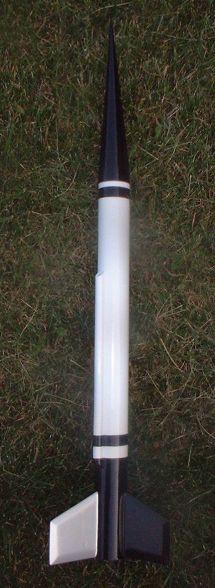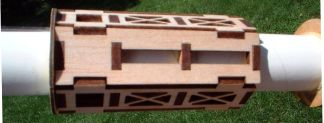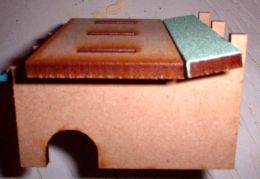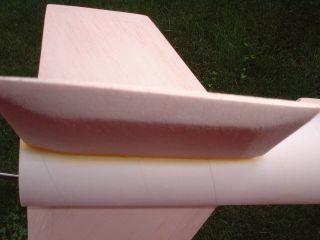| Construction Rating: | starstarstarstarstar_border |
| Flight Rating: | starstarstarstarstar |
| Overall Rating: | starstarstarstarstar_border |
| Manufacturer: | Qmodeling  |

Brief:
Relatively tiny for the "Mega" line of Estes upscales, this WAC is a
fine looking scale kit and great flyer. An excellent kit in every way even
though at $50 list, scale builders on a budget might consider the ASP 24mm
version (listing for $20).
Construction:
I ordered this kit online (actually won it on eBay) and the kit arrived
Priority Mail 3 days later. Everything was in great shape, though you'll be
surprised at how much material comes out of the small triangular box. Parts
list includes:
- Resin cast nose cone
- BT-60 body tube
- Balsa fins (laser cut, 1/8" balsa)
- Balsa tunnel/conduit pieces (laser cut)
- 24mm foil-lined motor tube
- motor mount assembly
- sanding jig components
- Nomex® heat shield (9x9)
- 30" rip-stop nylon chute w/swivel
- Kevlar® shock cord
QModeling doesn't skimp on components and all were about the finest quality you'll find. I especially like the foil-lined motor tubes, something not found in very many commercial kits these days.
Instructions were very well illustrated and generally easy to follow, though I did manage a couple of minor goofs (mostly my own fault). The construction is set up in stages with each stage having rough time estimates, so you know what you're in for and whether or not you can get that section done before it's time to turn in for the night.
Having previously built an ASP WAC Corporal, I have to admit I wasn't terribly excited when I heard about QModeling's release. The thing that pushed me over the edge though, is the fin sanding jig that's part of this kit. The WAC has very precisely beveled fins and it is difficult to get the lines sharply pronounced, visible, and even. I really like the anal-retentive design team at QModeling (OK, detail-oriented) and before beginning construction of the WAC, you get to assemble a fin sanding jig to get exactly the right size and angle on the bevels. Fortunately, this is pretty easily done with pre-cut parts simply put together and glued.
 Moving on
to the motor mount assembly is when I ran into my first "gotcha". If
you've never built a QModeling kit before, you'll find the motor mount assembly
quite a bit more complex than the basic tube/centering ring approaches out
there. This company uses very finely crafted balsa frames tacked onto balsa
rings to form a lightweight yet very strong frame. This was at least my 3rd or
4th QModeling kit though, so I blew through this step with a bit too much
confidence and didn't pay close enough attention to the detailed instructions.
There are 4 rings that form the base of the frame structure. There is one line
to mark on the motor tube. I foolishly assumed this is the aft most ring
location and tacked mine in place, then started lining up the mating parts. I'm
not a total idiot though and decided before gluing the assembly into the body
tube that I'd better check the alignment with the through-the-wall fins. Not
even close. If I flipped the balsa frames (they're asymmetrical, with a
definite forward and aft end) and everything fit fine. I contacted QModeling to
alert them to this error, and after a couple of emails and phone calls, we
finally figured out that the line marked on the tube is for the SECOND ring,
not the aft ring! The instructions noted this but I didn't catch it. Moral of
the story: pay attention to the instructions (although QModeling is revising
the instructions for clarity). My suggestion would also be to mark all 4 ring
lines to eliminate any doubt.
Moving on
to the motor mount assembly is when I ran into my first "gotcha". If
you've never built a QModeling kit before, you'll find the motor mount assembly
quite a bit more complex than the basic tube/centering ring approaches out
there. This company uses very finely crafted balsa frames tacked onto balsa
rings to form a lightweight yet very strong frame. This was at least my 3rd or
4th QModeling kit though, so I blew through this step with a bit too much
confidence and didn't pay close enough attention to the detailed instructions.
There are 4 rings that form the base of the frame structure. There is one line
to mark on the motor tube. I foolishly assumed this is the aft most ring
location and tacked mine in place, then started lining up the mating parts. I'm
not a total idiot though and decided before gluing the assembly into the body
tube that I'd better check the alignment with the through-the-wall fins. Not
even close. If I flipped the balsa frames (they're asymmetrical, with a
definite forward and aft end) and everything fit fine. I contacted QModeling to
alert them to this error, and after a couple of emails and phone calls, we
finally figured out that the line marked on the tube is for the SECOND ring,
not the aft ring! The instructions noted this but I didn't catch it. Moral of
the story: pay attention to the instructions (although QModeling is revising
the instructions for clarity). My suggestion would also be to mark all 4 ring
lines to eliminate any doubt.
After completing the basic motor mount assembly, the Kevlar® shock cord is attached to the tube just below the forward centering ring. This is a huge improvement over tri-fold paper attachment and a must for a kit of this size and class. The completed assembly is then glued into the body tube, carefully aligned with the fin slots.
 Next up is
construction of the tunnel/conduit. This is comprised of two side pieces and a
top, glued together, then sanded down into a rounded shape. While it would have
been easier and cheaper to simply include a balsa half-dowel, this conduit
serves a second purpose: it hides the launch lugs.
Next up is
construction of the tunnel/conduit. This is comprised of two side pieces and a
top, glued together, then sanded down into a rounded shape. While it would have
been easier and cheaper to simply include a balsa half-dowel, this conduit
serves a second purpose: it hides the launch lugs.
Mounting the conduit to the body tube is where you'll run into another potential gotcha. Since it contains the launch lugs, the conduit obviously has to be slightly off the fin line, and the instructions clearly note this. The real WAC though has the conduit precisely on the fin line and by moving this offline, you've got something that might look like the Estes kit but just doesn't look quite right. This forces a trade-off--either exposed launch lugs and clean lines or hidden lugs and off center conduit. I opted for off center conduit and think the better move would have been to keep it on the fin line, tuck the lugs against the side of the conduit and fin, and fill in the conduit for a more authentic appearance.
Once the conduit has been mounted, it's time to start working on the fins. I spent hours on my ASP kit and did a decent but not great job on the bevels. Thanks to the sanding jig on this kit, it only took about 30 minutes to do a great job on all 3 fins. This was a huge time-saver and is by far the best feature of this kit. Once sanded, the fins are then glued into place and filleted.


All in all, this was a very easy build. Excluding the time spent on finishing and paint prep, most builders could have this put together in about 3 hours.
Finishing:
I tend to do most of the "finishing" work at the beginning of a
construction project, filling tube spirals and balsa grain is a heck of a lot
easier before things get glued together and in the way. With visions of
perfectly beveled fins dancing through my head, I went over the top on the prep
and fill, figuring this could be a NARAM scale entry (the offline conduit shot
down that idea, unfortunately).
The tube spirals are typical, and easily filled with Elmer's Fill 'n' Finish. One application takes care of about 90% of the problems and the rest is covered by a couple of coats of Plasti-Kote primer.
I used 3 coats AeroGloss balsa sealer for the fins. This doesn't build up like Elmer's, and penetrates more than it covers. For the beveled fins, I thought this was fairly important, as Elmer's might change the angles a bit. I hate the fumes and the cost but have to admit it does a great job.
After a couple of primer coats, I then applied three light coats of Krylon gloss white. After allowing a couple of days for drying (if it smells like paint, it's not dry), I then masked off to paint the "primary" fin silver and then followed up a day later with the black stripes and sections. Masking and painting this rocket is challenging--the stripe goes over the conduit and there is a very small white band at the top that gets masked off.
The finished product is well worth the work.
Construction Rating: 4 out of 5
Flight:
The recommended motors for this are a D12-3 and an E9-4. It's only 28"
long but pretty heavy (mine weighed in at just under 6 ounces), so I think the
D12 is more for backyard flying...
I chose the E9-4 (the long, slow burn of the Estes E9's are in my opinion the best bang for the buck in the hobby). The rocket weathercocked slightly in the 8-10mph winds, arched over, and popped the chute just past apogee. My chute got tangled a bit in the miles of Kevlar®, and wound up taking 5-6 seconds to open. When it did though, it was a magnificent sight. The bright orange 30" chute really fills the sky. It's also overkill for this rocket and even though I only hit about 400-500 feet, I had a long walk for recovery. Considering the heavy-duty components, I think a 24" chute could bring this down without any damage.
The Nomex® is also a very nice feature with this kit and makes flight prep virtually no work at all. The 9x9, like the chute, is a bit overkill, as a 6x6 square would be more than enough protection in a BT-60 tube.
Now to try to pick up a couple of Econojets and kick this up on an F...
Recovery:
After needling QModeling about the flimsy Mylar chute in my first kit from
them, they have really come back with the best recovery package I've ever seen
in modrocs. The Top Flite chute and Nomex®,
plus the Kevlar®
shock cord are fantastic and you'll want to use these in every rocket you've
got. You can afford to--they're built for the long run.
Flight Rating: 5 out of 5
Summary:
I'm a huge fan of QModeling in general and believe they make great kits, using
the top materials available, and have sophisticated designs that are a pleasure
to build. This kit, being the baby of their fleet, is a bit overpriced. If
you're looking for a WAC, try the ASP. If you're looking for a great kit and
nice build project, pick this one up.
The pros include the sanding jig, components that fit perfectly, outstanding recovery system and fantastic quality. I also have to say this is about as good as you'll ever get on customer service. When I mentioned my motor mount dimension/alignment problem, Tom Quinn went well above and beyond to make sure I not only got it worked out, but to kick around ideas on how the kit could be improved to prevent anyone else from making my mistake. I'm sure there are companies out there that would just point to the instructions and say "Duh. The instructions are right, so it's your problem not ours." QModeling however, truly cares about customers and feedback.
Cons are hard to find on this kit. Maybe with better dimensional marking of the motor tube, and a slightly smaller chute (bringing down the price a couple bucks?) and a true scale conduit approach it would rate a perfect score.
Overall Rating: 4 out of 5
Other Reviews
- Qmodeling WACC By Fred Talasco
(by Fred Talasco - 06/10/04) Brief: Mid power scale model upscaled from the Estes WAC Corporal. Construction: The model is based on the BT-60 and has a 24mm 'E' length engine mount which makes the kit over 28 inches tall. The nose cone is injection molded of a soft plastic with a laser cut wooden plug that also serves as a screw eye mount. The fins, TTW fin mount braces, and fuel ...
- Qmodeling WACC By Bob Cox
( Contributed - by Bob Cox - 07/25/04) Overview The MRS-WAC Corporal is part of QModeling’s Mega-Retro Series, up-scaled versions of Estes classics built with very high quality components. Kit Specifications (from the QModeling web site) Height: 28.0" Weight: 5.8 oz (with recovery system) Fin Span Diameter: 6.88" Main ...
 |
 |
Flights
 |
 |
B.C. (February 2, 2005)
B.C. (August 3, 2005)
J.H. (June 13, 2006)
Sponsored Ads
 |
 |












A.H. (January 30, 2005)